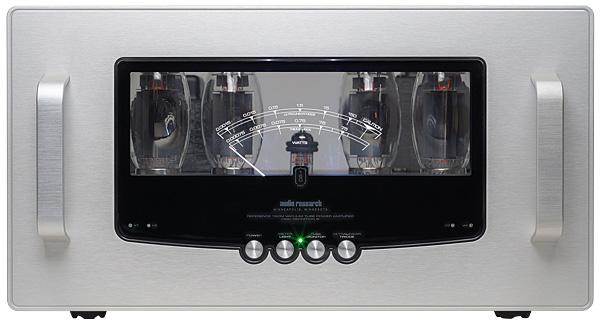Audio Research REF160M mono power amplifier

 Not just a new model but a radical change for the venerable Reference Series, the REF160M mono power amp heralds a fresh direction in both looks and performance
Not just a new model but a radical change for the venerable Reference Series, the REF160M mono power amp heralds a fresh direction in both looks and performance
A genius mix of both rebellion and restraint, Audio Research's latest chapter in the Reference saga, the REF160M monoblock power amplifier, is one of the biggest departures in the much-lauded series' evolution. Most obvious is the new look, which takes its cues from the G-Series, bringing with it a cool oversized meter, but the rest of the amplifier has been redeveloped, too, not least to incorporate features that will improve system matching, reliability, ease-of-use and initial set-up.
At £30k per pair, they seem almost sensibly-priced by today's standards, especially when you hear how they perform. Available in silver or black, a single REF160M is a fairly compact unit, at 438x254x457mm (WHD), with the handles adding 41mm; and its weight is a manageable 25.5kg. While we're on the topic of user-friendliness – and thanks to the features that are new to Reference models – actual installation is a dream. And I believe a stereo version will follow, a REF160S, should a brace of 'Ms demand too much of your space.
Choose Your Mode
Dave Gordon, recently elevated to Brand Ambassador, was effusive about one particular introduction to the family via this unit. By ARC standards, it is a monumental change first seen in the Foundation series' VT80. 'We wanted a reliable auto-bias circuit that would not degrade sound quality and we finally developed one. Carefully fusing the output tubes provides a great measure of protection and security.' Fittingly, this much-lauded development is a tribute to the late Ward Feibiger, who passed away last year: it was his last design for the company.
Another feature – and one which I found, after a week with the amps, to be truly invaluable for hands-on or finicky listeners – was the choice of Triode or Ultralinear operation. It meant the opportunity to dial in memories of Dynaco or Radford amps of 50 years ago with the ultralinear choice, or turning the clock back to the Pleistocene Era with Triode.
Says Gordon, 'Triode operation is treasured by some listeners but not useable by all, so we provide the ability to switch operation between Triode and Ultralinear on the fly. And, we added the flexibility to use a single-ended or balanced source with a Reference amplifier.'
Take note of that second observation, because there are hugely desirable control units, like early Nagras or classic Audio Research 'SP' preamps, that some might wish to mix 'n' match with modern Reference amps, but which lack balanced outputs... and purists do not like RCA-to-XLR adapters. A toggle on the back selects between the two modes, while the rear also contains speaker taps for 4, 8 or 16ohm loads and fan speed selection. The unit offers a panoply of remote power-on/off and system integration options.

Dancing Needles
First seen (I think) in the Reference 75SE stereo power amplifier, to which these were compared, the KT150 is the output tube of choice, benefiting from the new auto-bias feature. While the auto-bias technology will accommodate other octal-based tubes, the REF160M was designed and fine-tuned for use with the KT150. When I asked if the amp could be ordered with KT88s, KT120s, 6550s or others, the UK importer snorted, 'Why? Do you want to lower the performance?'.
I have to agree: the KT150 has proved to be one of, if not the finest of newborn 21st century valves. When pushed, he let out a sigh of dismay, like a Savile Row tailor being asked if he would substitute cotton for a suit's silk lining. 'We will supply other tubes, but the amplifiers will be delivered with KT150s, and prices for replacements will be dictated by market values.' His caution is understandable, with UK charges fluctuating almost daily when dealing with American, Russian or Chinese-made vacuum tubes.
So in-your-face is the new meter that it may prove divisive. Susceptible as I am to the allure of old-style mechanical meters, with black needles against a white dial, I admit to be taken aback by the sleek, ultra-modern look of arched scales etched into Perspex, with a big, illuminated indicator. The needle's activity was a ballet of its own as I used the amplifier through the Wilson Yvettes [HFN Feb '17], and moved from Triode to Ultralinear, head-banging to whisper-soft. Their action was swift and the ascent followed sudden shows of bombast in the signal with confidence [see PM's Lab Report].
Alongside the power on/off button below the clear fascia are buttons for the levels of illumination; tube monitoring, which uses the scales to keep an eye on valve condition; and the Triode/Ultralinear selector. Should you wish to gaze upon the lit tubes with the perforated cover in place, the meter-window frames them beautifully.
Subtle Differences
My only whinge about the front panel as a way of monitoring activity was the choice of blue and green for the LED that indicates Triode or Ultralinear operation. The unit is rated conservatively at 140W in Ultralinear mode, the power effectively halving in Triode mode, but this drop was not sufficiently audible to be a giveaway unless really hammering the hell out of the units. Instead, one has to look at the LED at eye-level while pressing the mode select button to note the colour change.























































